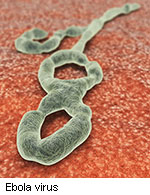
WEDNESDAY, Oct. 1, 2014 (HealthDay News) — Federal health officials are monitoring up to 18 people who were exposed to the man being treated at a Dallas hospital for the first confirmed case of Ebola in the United States.
Some of the 18 people are members of the unidentified man’s family. The group also includes the three-member ambulance crew that transported the man on Sunday to Texas Health Presbyterian Hospital, the Associated Press reported Wednesday.
The ambulance workers have tested negative for the highly lethal virus that has been ravaging several West African nations, and are confined to their homes for observation, the news service said.
“If anyone develops fever, we’ll immediately isolate them to stop the chain of transmission,” Dr. Tom Frieden, director of the U.S. Centers for Disease Control and Prevention, told the AP.
People who had contact with the patient will be monitored for fever during the next 21 days, which is the maximum incubation period for Ebola, Frieden said.
The patient flew to the United States from Liberia, arriving Sept. 20, federal health officials said Tuesday. He first developed Ebola symptoms Sept. 24 and sought care two days later, but was released from the hospital. Hospital officials didn’t know at the time that he had been in West Africa, the AP reported.
He was taken to Texas Health Presbyterian Hospital after his condition worsened.
The patient was “here to visit family who live in this country,” and was staying with family when he fell ill, said Frieden, who declined to say whether he is an American citizen. As far as public health officials know, the man was not involved in the medical response to the ongoing Ebola epidemic in West Africa.
The man is the first patient ever diagnosed with Ebola in the United States, and the first patient outside Africa to ever be diagnosed with the Ebola Zaire strain, Frieden said at a Tuesday afternoon news briefing.
“The bottom line here is that I have no doubt we will control this case of Ebola so it will not spread widely in this country,” Frieden said at the briefing.
Frieden said the man had no symptoms during his flight from Liberia, and only fell ill four or five days later.
Frieden said there is “zero risk” of Ebola to people who shared the flight, since the virus can only be transmitted by someone suffering from symptoms.
Currently, public health officials suspect only a handful of people in Texas came into contact with the patient since he fell ill, including some family members and friends.
Frieden stressed that Ebola is not easily transmitted — to become infected a person must come into direct contact with the bodily fluids of a person who is suffering symptoms. Those symptoms include fever, muscle pain, vomiting and bleeding and can appear as long as 21 days after exposure to the virus.
On Tuesday, the Dallas hospital issued a statement in which it said it was taking all precautions. “The hospital is following all Centers for Disease Control and Texas Department of Health recommendations to ensure the safety of patients, hospital staff, volunteers, physicians and visitors,” the hospital said.
The new case in Dallas is the sixth to be treated in the United States since the West African outbreak began last spring. An unidentified American doctor who had been working in Sierra Leone is currently being cared for at a hospital at the U.S. National Institutes of Health in suburban Washington, D.C.
Three others who became infected with the virus have recovered, while a fourth continues to undergo treatment at Emory University Hospital in Atlanta.
The Ebola epidemic in West Africa is the worst outbreak ever of the disease. So far, an estimated 6,500 people have become infected and nearly 3,100 have died in the countries of Guinea, Liberia, Nigeria and Sierra Leone, according to the World Health Organization.
The epidemic could strike as many as 1.4 million people by mid-January unless the global community mounts a rapid response to the crisis, according to estimates by the CDC.
More information
For more information on Ebola virus, visit the U.S. Centers for Disease Control and Prevention.
Copyright © 2025 HealthDay. All rights reserved.

